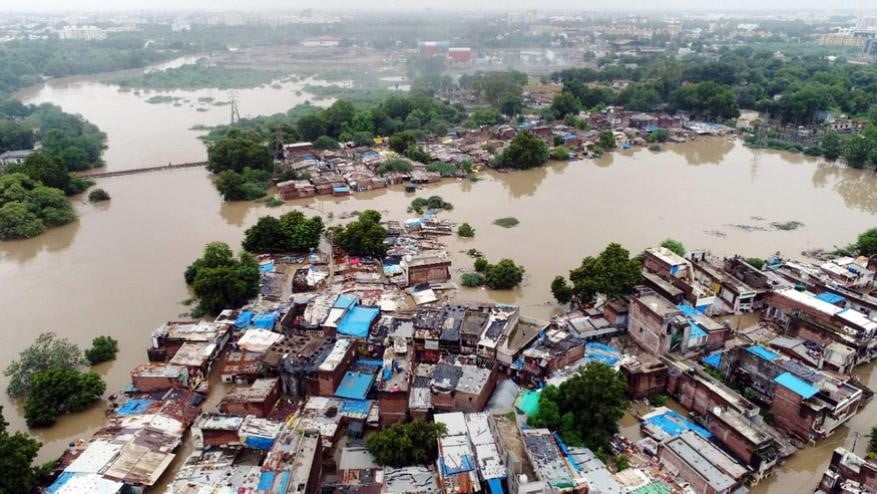A government reply in the Indian Parliament’s lower house (Lok Sabha) this fortnight revealed that at least 6,585 people were killed in rain-related natural calamities in the three years ending July 18, 2019 – an average of 2,000 every year. Bihar lead the toll list at 970 (15% of the deaths) followed by Kerala at 756, West Bengal at 663, Maharashtra at 522 and Himachal Pradesh at 458.
What’s worse is that India could see a six-fold increase in the number of people facing the risk of severe flooding by 2040 – 25 million people compared to the 3.7 million between 1971 and 2004.
IPCC land report warns of dire desertification, carbon storage in soil pores offers glimmer of hope
A leaked draft of the Inter-governmental Panel on Climate Change (IPCC) report on land and climate change, due to be formally released on August 8, has claimed in no unclear terms that humans have contributed to the degradation of a quarter of the world’s ice-free land including through urban expansion which has reportedly eaten into 35 million ha of forests and 22 million ha of shrubland between 1992 and 2015. The IPCC report further asserts that climate change has been increasing land degradation and desertification evident by the fact that populations living in desertifying areas stood at up to 620 million in 2015, up 300% compared to populations in 1961. The findings are especially ominous for India and other South Asian countries where about half of the vulnerable population resides. Assessments of desertification in the country have revealed that nine-out-of-ten Indian states are undergoing desertification, covering up to 30% of India’s total geographical area.
While the report advocates for a shift in agricultural practices to focus on sustainability and reduction in emissions, it also notes with concern that prioritisation of afforestation to increase carbon sequestration potential of land could end up increasing food prices and food insecurity. Interestingly, a study released this week could show how soil pore structure influenced by microbial and plant diversity may help design agricultural systems that maximise soil sequestration and reduce agricultural emissions.
Can’t project future sea-level rise until 2060 due to Antarctic instability: Study
We won’t know until 2060 by how much sea levels will rise by the end of the century – this scary outcome was explained in a detailed study on the instability of the Antarctic ice sheet by Rutgers University-New Brunswick. Researchers have so far pointed to two scenarios when it comes to sea-level rise by 2100 – the less-severe prediction is 2 feet and the high-end scenario is 6 feet. But these predictions have been made based on marine-ice instability, which has been studied for decades. There is another pathway that can lead to ice-sheet instability, which is called marine ice cliff instability – which most studies have not taken into account. This type of instability could drive global sea level much higher than projected in the Intergovernmental Panel on Climate Change (IPCC)’s 2013 assessment report and in a 2014 study led by Kopp.
This, along with another study, which concluded that underwater glacial melting is occurring much faster than previously thought, has put a real question mark on the level of risk we should brace for in terms of rising sea levels.
As world sees hottest month ever, study reveals that current climate change unseen in past 2,000 years
July 2019 has been confirmed as Earth’s hottest month on record by EU’s Copernicus Climate Change Service (C3S). While scientists involved in the assessment claim that this is a sign of unprecedented warming, separate research has in fact shown that global climate is changing faster now than it has in the past 2,000 years. The unique study, based on data collected from almost 700 proxy records of ice cores, trees, corals, among other substances, which change their composition or appearance based on global temperatures, was published in the journal Nature Geoscience.
What the study found was that in the past, like during the Little Ice Age or the Medieval Climate Anomaly, temperatures rose and fell at different times in different regions or in other words the change was localised. Modern climate change, however, seems to be having a more global reach. “…for 98% of the planet’s surface, the warmest period of the Common Era occurred in the late twentieth century,” Scott St. George, a climate researcher at the University of Minnesota who wasn’t involved in the research, wrote in a news and views article for Nature.
200 reindeer in Arctic starved to death because of climate crisis: Researchers
The climate crisis has claimed the lives of 200 reindeer – an unusually high number – in the Arctic archipelago Svalbard, according to the Norwegian Polar institute. While conducting a census of the wild reindeer population in the region, three researchers from the institute found the carcasses of 200 deer they believe died because of starvation last winter. According to Ashild Onvik Pedersen, the head of the census, climate change has increased the amount of rainfall in the region, which forms a layer of ice on the tundra, making grazing conditions tough for animals.
Another study pointed out that animals in general are failing to adapt to the speed of climate change. This includes common species such as sparrows, deer and magpies.
About The Author
You may also like
Win for small island states as top maritime court calls GHG emissions a form of marine pollution
Climate warming is altering food webs and carbon flow in high-latitude areas: Study
Rise in temperature leading to increased suicide rates in US, Mexico: Study
Seafood to lose nutritional value due to climate change: Study
14.5 million lives may be lost by 2050 due to climate change: WEF report


